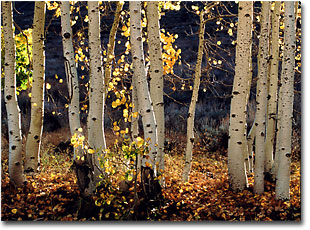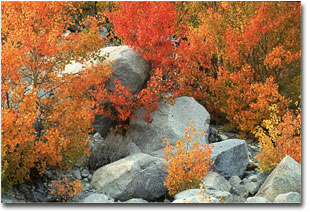|
|

Artist's Perspective... Color and Light in Photographic Composition
Text and Photography Copyright Dale Proctor
Do you ever wonder what is the one major thing that would elevate your photography to a new level? I sure do. That special something, which would change the way your photographs are viewed and received? Well, there is something you could do to make your photographs stand out, look better, grab attention, and have greater impact. That “something” is what photography is all about - light. Sure we hear and read about it all the time, WOW that’s some great light, photograph the light, warm light, magic light, quality light, referring to the color of light, and its temperature. Then there is talk of frontal light, side lighting, backlighting all of which is the direction of the light’s source. Also, we have light’s intensity, such as low angled morning light as the sun just begins to peek over the horizon bringing with it quality color as the new day begins. High clouds blocking the intensity of the suns direct light, patchy clouds creating dappled lighting on the land, thick cloud cover turning a bright day to doom and gloom. All of these lighting conditions make for fantastic photography if you learn to use the light to your advantage. Yes, it is possible to photograph at high noon on a bright sunny day and create a wonderful photograph. One thing for sure, I didn’t say it was easy. When was the last time you went outside for the sole purpose of looking at the way the light is falling on the land? Do you notice which direction shadows are going, see the void they create when the light is bright creating high contrast? Do you step out and see the light at the beginning and end of the day just to see its color? If not, why not? You’re a photographer aren't you? Photographers need to photograph the light in order to take better photographic images. Let's focus on the light, how we see to photograph in color photography When I head out in the field to photograph, the return trip always provides me with subjects I never dreamed of photographing. Sure I have a general idea of what I am going out to photograph, but what I really go out to photograph are things I find in the best light available. And, those things may or may not be what I was originally after. I explore and photograph in light where I know the film I am using works best. I have tested my film and know its characteristics, how it will respond in different lighting situations. I avoid bad light by reviewing my slides on my light table and keeping this in mind, when I go out in the field to photograph. I have created my own little “system” to self critique my work. It’s really very simple and quite effective. I place small index cards with words like exposure, light, composition, depth of field, sharpness etc. at the top of my light table. As I view the slides they go in their respective places except the images which work well-my “keepers.” Then, the card which has the most slides placed on it is the area where I need the most work. With me, it’s always the light.
So what does light have to do with art and photographic composition? The answer is everything. Light is powerful. Without light, we have no color and I make color photographs. As the light intensity is increased we begin to see shapes. We can see just enough to walk without bumping into things. As more light becomes available, we can then begin to see lines and the beginning of color. Using angled light, we can reveal nature’s wonderful textures, shapes, depth in our photographs. Strong light makes strong shadows, which when used properly, will create depth in your photograph. As the light lifts from the horizon, these shadows become shorter. At the same time the sun is lifting into the sky, the color of light is rapidly changing. This is part of the reason we see what’s called Alpenglow at both ends of the day. Everything that happens with the light in the morning hours happens in the evening hours too, in reverse. The color of morning light changes from the warm red glow, amber, and yellow to white. Then, in the afternoon the same thing happens with the color changing from white to yellow to amber then the nice red glowing sunset. Although I have simplified this daily process it happens every day. Living in our modern world, industries daily operation creates pollution. This is present more in the afternoon/evening atmosphere. This atmospheric haze can contribute to wonderful light at sunset. When there are heavy clouds, of course, we can’t see the color of the light because of the filtering, but it is there on the other side of those clouds. Because the light is being blocked to a certain degree and the color with it, guess who needs to use a filter to bring the temperature back to where the film is balanced? This is where you hear photographers speaking of warming filters, the 81 series filters. Taking the time to see the light, its color, direction, and intensity will give the photographer more understanding of photography. The importance of light in photography is far underrated in favor of technical things which bring money like equipment. We can spend all our hard earned money on every gadget in the book, but you'll never be able to buy your way to a beautifully lit photograph without knowing the light. It's as simple as that. Get to know the light as an "old friend" and you'll be more than happy to see it. Editor's Note - Visit Dales web site at www.californiapictures.com to view more of his work. DP - NPN 368 Comments on NPN California landscape photography articles? Send them to the editor. |
|
|
 A sharp rise in the background mountain terrain capped with vertical cliffs provides just enough time (seconds) to make subjects in backlighting from this high Eastern Sierra canyon location. Placing the camera position in the protective shadows provided by these Aspen tree trunks lowered the chances of the direct sunlight, creating unwanted lens flare. When using a slower shutter speed as was used in this photograph, a sturdy tripod and cable release becomes the photographer’s friend. Although it was morning, the sun had already been shining for a couple of hours. High walled canyons block the true magic light as the sun breaks from the horizon. Exploring for colorful scenes is a must as light turns to daylight temperature. Fuji's Provia F provided excellent results. Nikon N90s, Nikkor 105mm 2.8 Macro, Provia F @100, Tiffen cir. polarizer, Bogen 3021 w/3047, electronic release, F11.0 1/8 sec.
A sharp rise in the background mountain terrain capped with vertical cliffs provides just enough time (seconds) to make subjects in backlighting from this high Eastern Sierra canyon location. Placing the camera position in the protective shadows provided by these Aspen tree trunks lowered the chances of the direct sunlight, creating unwanted lens flare. When using a slower shutter speed as was used in this photograph, a sturdy tripod and cable release becomes the photographer’s friend. Although it was morning, the sun had already been shining for a couple of hours. High walled canyons block the true magic light as the sun breaks from the horizon. Exploring for colorful scenes is a must as light turns to daylight temperature. Fuji's Provia F provided excellent results. Nikon N90s, Nikkor 105mm 2.8 Macro, Provia F @100, Tiffen cir. polarizer, Bogen 3021 w/3047, electronic release, F11.0 1/8 sec.
 Late afternoon sun was beaming in from the left at this quiet location in California’s Eastern Sierra. I waited patiently making close up leaves images until the light, which was harsh and falling, dappled upon this grove along the trail became “user friendly.” Huge granite boulders had fallen from the canyon walls, course textures and blinding reflections were extreme. Waiting for the light allowed for the contrast to fall into the exact range where my film, Fuji Velvia performs at its best. Knowing your film plays an active role in capturing quality images, you must look for scenes which fit within the films range to be successful. Even though the sun was not shining directly upon this scene you can't afford to be reckless. The blue sky overhead was the main light source (ambient) and must be filtered or suffer the ill effects of blue/cyan cast to your film. Nikon N90s, Nikkor 80-200mm 2.8, Velvia @50, 81b, Bogen 3021 w/3047, electronic release, F16.0 @ 1/2 sec.
Late afternoon sun was beaming in from the left at this quiet location in California’s Eastern Sierra. I waited patiently making close up leaves images until the light, which was harsh and falling, dappled upon this grove along the trail became “user friendly.” Huge granite boulders had fallen from the canyon walls, course textures and blinding reflections were extreme. Waiting for the light allowed for the contrast to fall into the exact range where my film, Fuji Velvia performs at its best. Knowing your film plays an active role in capturing quality images, you must look for scenes which fit within the films range to be successful. Even though the sun was not shining directly upon this scene you can't afford to be reckless. The blue sky overhead was the main light source (ambient) and must be filtered or suffer the ill effects of blue/cyan cast to your film. Nikon N90s, Nikkor 80-200mm 2.8, Velvia @50, 81b, Bogen 3021 w/3047, electronic release, F16.0 @ 1/2 sec.